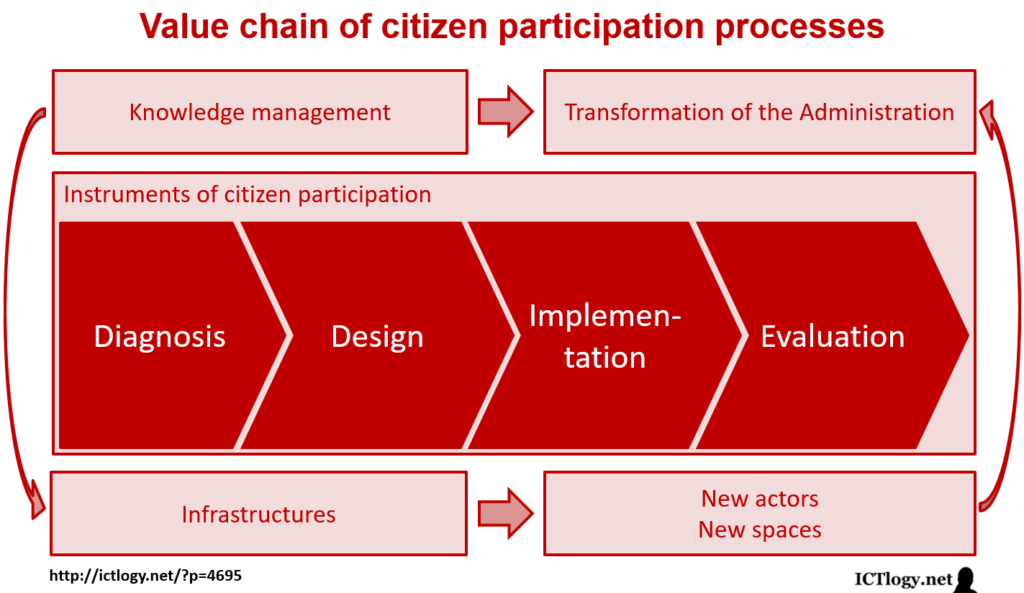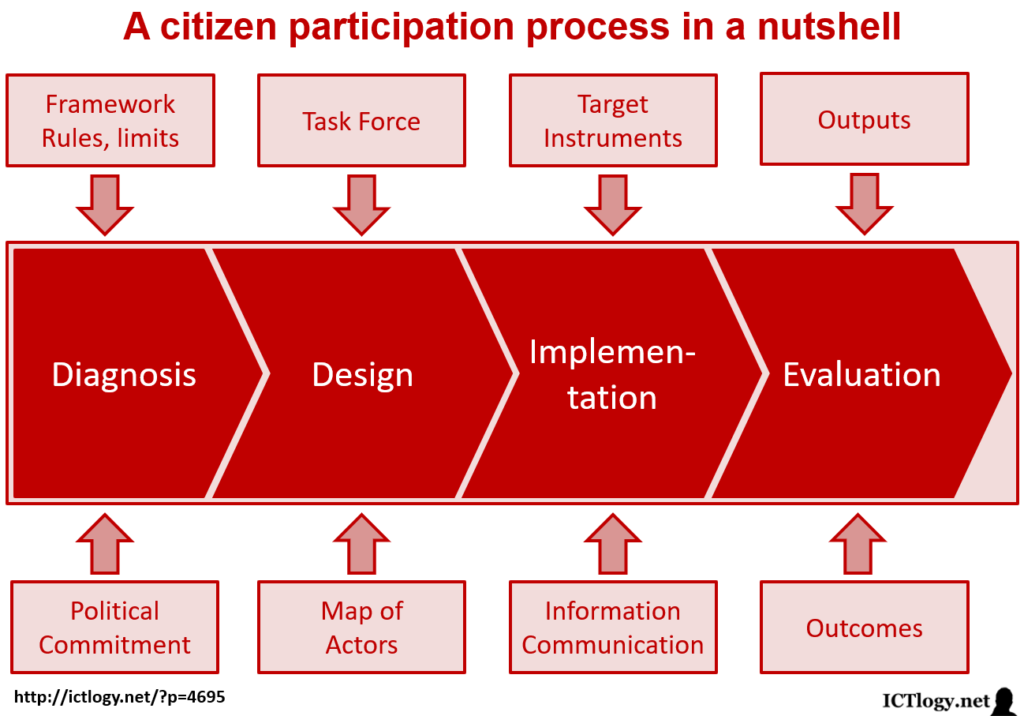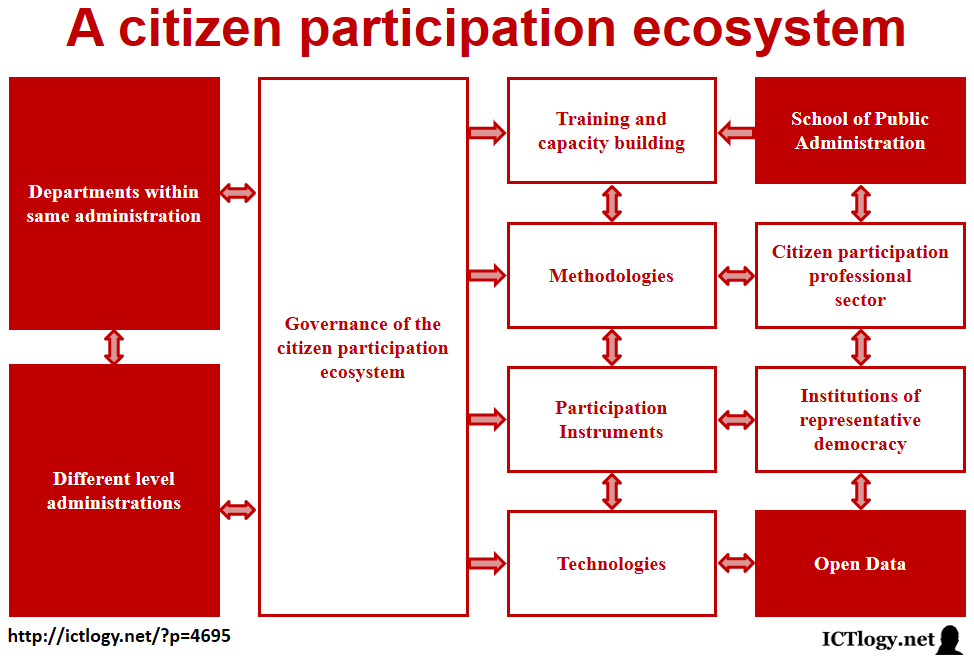Quite often, we tend to think about citizen participation as discrete processes that are created ad hoc for a given purpose, and are finished/shut down once the purpose has been achieved.
There are, nevertheless, two big objections to this way of thinking about citizen participation:
- On the one hand, it may reduce its effectiveness. Most participatory processes —if not all— are embedded in bigger decision- or policy-making initiatives. These initiatives usually require some follow-up just like monitoring and evaluation and assessment, as it is drawn in Figure 1. If citizen participation is not guaranteed to last until the real closing of the policy cycle, it may well happen that only minor goals are achieved, or that the major goals are simply not achieved.
- On the other hand, it may reduce its efficiency. If we look again at Figure 1, we will see that the resources devoted to the participatory instrument itself are but a part of the total. Indeed, having a good diagnosis and creating the information materials to raise awareness about it, map the different actors that should be called to participation, measure outputs and outcomes, etc. are the lion’s share of the total efforts. But many of these efforts are done just once. Making participation structural instead of a one-time project would contribute to pay back the investments, especially when it comes to mapping actors, raise awareness and build trust. That is: the effort to institutionalise social conflict.
A first change of approach would be to take the whole value chain of citizen participation processes (Figure 2) and include in it how it can (and in our opinion should) contribute to transform the Administration. This transformation should come in three fronts:
- Reflect on the procedures and internal organisation of the Administration and see where there is a room for improvement with the concurrence of citizens —an improvement which should become structural once the organisational architecture is changed.
- Open the infraestructures of decision- and policy- making so that they can be appropriated by the citizens and be used by them in their own collective processes.
- Map all the relevant actors, especially those actors that are more difficult to identify and/or reach because they operate in the outskirts of the system, in informal spaces and extra-institutional environments. Map them and engage them “permanently” by means of open infrastructures.
The thing is that to drive a thorough and deep change in the Administration, these three fronts are not enough. On the one hand, the impulse cannot only come from citizen participation, but as a comprehensive approach such as the one that could come from an implementation of an Open Government Department transversal all across the Administration.
On the other hand, the Administration will not be transformed unless all administrations are. This is where the idea of a citizen participation ecosystem becomes especially relevant. If we said before that participation has to become structural and move away from one-off initiatives, participation also has to become cross-cutting in all departments and at all levels of the public system.
For a transformation of the Administration where the citizen is put at the centre, and the citizen is empowered to contribute in making collective decisions, citizen participation must be capillary and pervasive:
- First of all, efforts have to be put in place so that there is a coordination both “horizontally” (within the same Administration) and “vertically”, along the different levels of the Administration, from the (supra)national level to the local level.
- This coordination has to be explicit, and thus be built a governance device of the whole citizen participation ecosystem.
- What does this governance device coordinates? At least four different aspects:
- What are the methodologies that are going to be fostered. Of course, methodologies is plural: citizen participation can be put forward by means of a good bunch of political instruments and ideological approaches. Hence, it is a good idea to speak about methodologies and about a toolbox or a toolset, instead of trying to find a one-size-fits-all kind of policy.
- How are people going to receive training on these methodologies. That is, what kind of training, capacity building, communities of practice and many other instruments are going to be put in place to share and transfer knowledge, and how is going the underlying ideology to be shared or agreed among peers.
- What kind of citizen participation instruments are going to embody this ideology and methodologies. We are talking about what kind of procedures and protocols, of activities, of pieces of information, of facilitation and intervention processes, etc. are going to be applied in order to make the best of the citizens’ wisdom.
- Last, which technologies are going to support the aforementioned methodologies and instruments. This is especially relevant because when one enters the digital realm, technologies become new intermediaries and also new pathways through which information and communication happens at top speed, having a non-negligible augmentation and multiplier effect.
- Among the necessary “accomplices” in a citizen participation ecosystem, the/a school of public administration plays a major role in standardising methodologies and making the different training instruments consistent among themselves. It also contributes to formalise tacit knowledge and encapsule it so that it is easier to transfer.
- Open data —and all other open government instruments such as transparency and accountability— are crucial to feed the ecosystem. There is no significant and meaningful participation without proper data and information.
- Last, all other institutions of representative democracy have to be involved in the citizen participation ecosystem. It makes poor sense to confine participation in a single department or even the whole government but without the concurrence of other institutions like parliaments, political parties, labour unions or civil society organizations.
- Among these other institutions, a healthy and networked professional sector —understood in very broad terms, both for profit and non-profit— is essential to be able to reach each and every corner, especially new intermediaries in citizen engagement.
Summing up, for a strategy on citizen participation to be comprehensive and transformative at the core-level of the Administration it has to unfold the whole potential of all the pieces in the value chain of the citizen participation process, especially infrastructures, actors and spaces and all the knowledge gathered. Then, this potential has to be driven towards the Administration itself, to change its habits and its culture. To achieve this change of culture, citizen participation has to be applied at all levels and all departments in a coherent, consistent and comprehensive way, including all surrounding actors of the public system, thus conforming a whole ecosystem of citizen participation.
If you need to cite this article in a formal way (i.e. for bibliographical purposes) I dare suggest:
Peña-López, I. (2019) “A citizen participation ecosystem” In ICTlogy,
#192, September 2019. Barcelona: ICTlogy.
Retrieved month dd, yyyy from
https://ictlogy.net/review/?p=4695
Previous post: Defining and promoting new intermediaries in citizen engagement
Next post: Article. Open government in new digital states: which libraries for which citizens?
3 Comments to “A citizen participation ecosystem” »
 RSS feed for comments on this post.
TrackBack URI
RSS feed for comments on this post.
TrackBack URI





Pingback: ICTlogy » ICT4D Blog » The role of public facilities and civic centres in a citizen participation ecosystem
Pingback: ICTlogy » ICT4D Blog » Three challenges of citizen labs
Pingback: ICTlogy » ICT4D Blog » REPORT. Catalan Participation Lab Network. Public facilities and social innovation